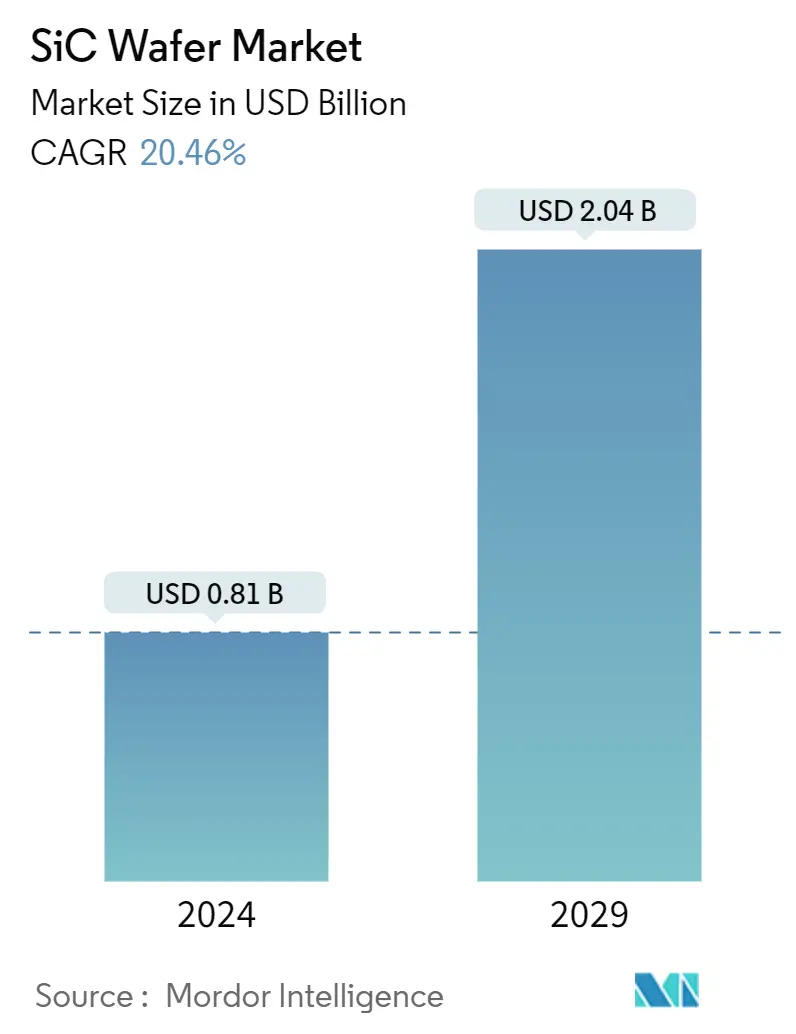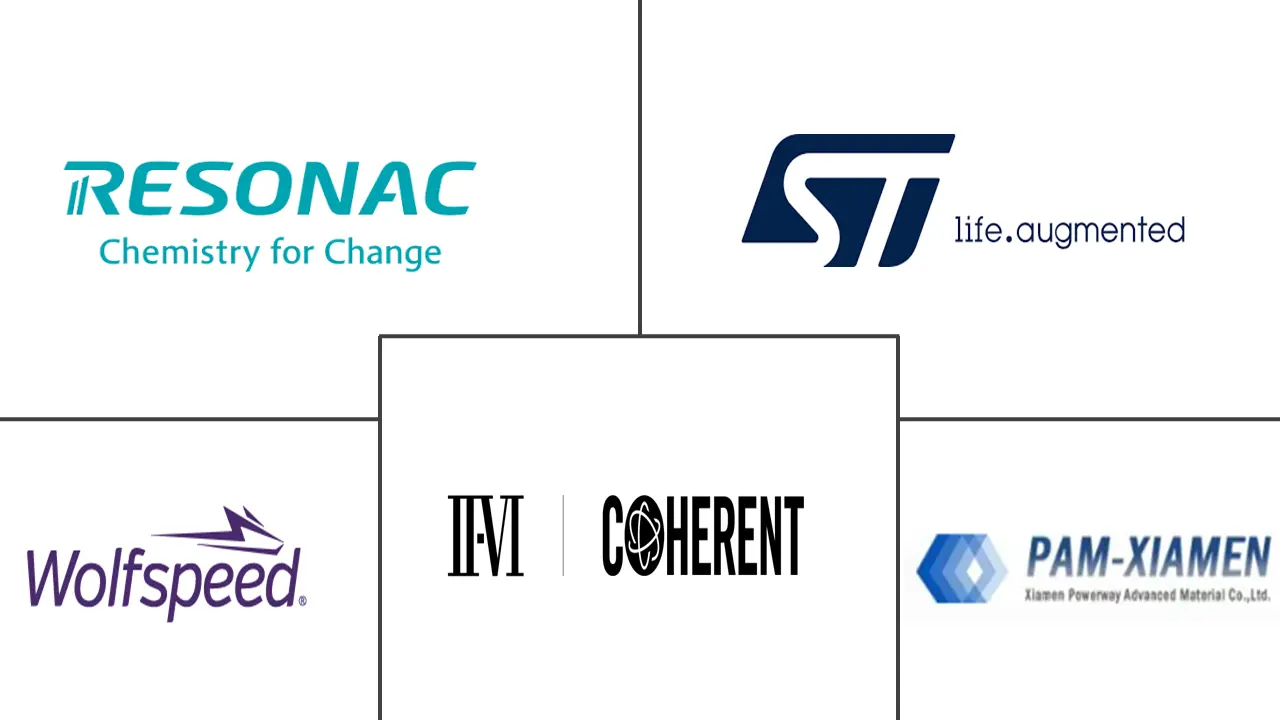Market Size of SiC Wafer Industry

| Study Period | 2019-2029 |
| Market Size (2024) | USD 0.81 Billion |
| Market Size (2029) | USD 2.04 Billion |
| CAGR (2024 - 2029) | 20.46 % |
| Fastest Growing Market | Asia Pacific |
| Largest Market | Asia Pacific |
Major Players
*Disclaimer: Major Players sorted in no particular order |
Need a report that reflects how COVID-19 has impacted this market and its growth?
SiC Wafer Market Analysis
The SiC Wafer Market size is estimated at USD 0.81 billion in 2024, and is expected to reach USD 2.04 billion by 2029, growing at a CAGR of 20.46% during the forecast period (2024-2029).
SiC semiconductors can endure ten times higher voltage than the existing semiconductors and operate at 400⁰C temperature, unlike the existing silicon semiconductors with a ceiling of 175 degrees. They also have a high-intensity level and can reduce the volume to one-tenth of silicon chips.
- In the automotive industry, new EVs have reduced charge time and increased range and performance to meet customer expectations. Hence, automotive companies require power electronic devices capable of effective and efficient operation at elevated temperatures to offer the above-mentioned advantages to customers. Thus, power modules are being developed using wide-bandgap SiC technologies, owing to the advantages of SiC-based technology, such as high thermal conductivity, reduced switching losses, higher power density, and increased bandwidth capability.
- Power electronics play an essential role in the global electrical infrastructure. The technology is used in transportation (cars and trains), renewable energy (solar and wind), industrial (motor drives), and computing (power supplies). SiC is also used to make LEDs. Power electronics convert or transform alternating and direct current in systems.
- The growing demand for energy and the increasingly widespread use of renewable energy resources have allowed microgrids to play a fundamental role in the reduction of greenhouse gas emissions and in the reduction of energy derived from fossil fuels. However, silicon-based solid-state inverters and switches are too bulky and inefficient to be used in the microgrid system. WBG semiconductors such as SiC, thanks to their higher breakdown voltage and switching frequency, are proposing themselves as a fundamental component in the construction of efficient and reliable microgrids.
- A larger wafer size offers more dies per unit area. The extra space to fabricate more dies enables semiconductor fabrication plants and OSATs (outsourced semiconductor assembly and test) to manufacture, test, or assemble more dies in a specific time. This increases the rate at which new products can be fabricated or assembled. To some extent, increasing wafer size also impacts the supply chain positively.
- The semiconductor industry has been affected significantly by various geopolitical scenarios, including the Russia-Ukraine War and the China-US Tech War, as well as a decline in consumer spending within the consumer electronics industry. This has had a direct impact on the supply and demand of SiC wafers in the global market. The semiconductor industry has faced several challenges over the past two years, including the COVID-19 pandemic and a lack of capacity to meet growing demand.
SiC Wafer Market Segmentation
SiC is a silicon-carbon semiconductor compound that belongs to the wide-bandgap class of materials. The semiconductor's strong physical bond provides excellent mechanical, chemical, and thermal stability. The wafering process involves converting a solid puck of SiC into an epi- or device-ready prime wafer.
The SiC wafer market is segmented by wafer size (2-, 3-, and 4-inch, 6-inch, and 8- and 12-inch), application (power and radio frequency (RF)), end-user industry (telecom and communications, automotive and electric vehicles (EVs), photovoltaic/power supply/energy storage, industrial [UPS and motor drives]), and geography (North America, Europe, Asia-Pacific, and Rest of the World). The market sizes and forecasts have been provided in terms of value (USD) for all the segments mentioned above.
| By Wafer Size | |
| 2-, 3-, and 4-inch | |
| 6-inch | |
| 8- and 12-inch |
| By Application | |
| Power | |
| Radio Frequency (RF) | |
| Other Applications |
| By End-user Industry | |
| Telecom and Communications | |
| Automotive and Electric Vehicles (EVs) | |
| Photovoltaic/Power Supply/Energy Storage | |
| Industrial (UPS and Motor Drives, etc.) | |
| Other End-user Industries |
| By Geography | |
| North America | |
| Europe | |
| Asia-Pacific | |
| Rest of the World |
SiC Wafer Market Size Summary
The SiC Wafer Market is anticipated to experience substantial growth in the coming years. This growth is fueled by the superior properties of SiC semiconductors, such as their ability to endure higher voltage and operate at elevated temperatures compared to existing semiconductors. The demand for SiC wafers is increasing in various sectors, including the automotive industry, where they are used in the development of power modules for new EVs. SiC technology is also essential in power electronics, which plays a crucial role in the global electrical infrastructure, used in transportation, renewable energy, industrial, and computing applications. In addition to these applications, SiC wafers are gaining traction in the radio frequency (RF) segment due to their exceptional electronic and thermal characteristics. They are increasingly being used in various commercial applications, including RF power amplifiers in 5G wireless base station antennas. The demand for SiC wafers is further boosted by the global deployment of 5G wireless connections. Moreover, the SiC Wafer Market is highly competitive and fragmented, with several influential players focusing on expanding their customer base across foreign countries through strategic collaborative actions.
Explore MoreSiC Wafer Market Size - Table of Contents
-
1. MARKET INSIGHTS
-
1.1 Market Overview
-
1.2 Industry Attractiveness - Porter's Five Forces Analysis
-
1.2.1 Bargaining Power of Suppliers
-
1.2.2 Bargaining Power of Buyers
-
1.2.3 Threat of New Entrants
-
1.2.4 Threat of Substitute Products
-
1.2.5 Intensity of Competitive Rivalry
-
-
1.3 Technology Insights
-
1.4 Impact of COVID-19 Aftereffects and Other Macroeconomic Factors on the Market
-
-
2. MARKET SEGMENTATION
-
2.1 By Wafer Size
-
2.1.1 2-, 3-, and 4-inch
-
2.1.2 6-inch
-
2.1.3 8- and 12-inch
-
-
2.2 By Application
-
2.2.1 Power
-
2.2.2 Radio Frequency (RF)
-
2.2.3 Other Applications
-
-
2.3 By End-user Industry
-
2.3.1 Telecom and Communications
-
2.3.2 Automotive and Electric Vehicles (EVs)
-
2.3.3 Photovoltaic/Power Supply/Energy Storage
-
2.3.4 Industrial (UPS and Motor Drives, etc.)
-
2.3.5 Other End-user Industries
-
-
2.4 By Geography
-
2.4.1 North America
-
2.4.2 Europe
-
2.4.3 Asia-Pacific
-
2.4.4 Rest of the World
-
-
SiC Wafer Market Size FAQs
How big is the SiC Wafer Market?
The SiC Wafer Market size is expected to reach USD 0.81 billion in 2024 and grow at a CAGR of 20.46% to reach USD 2.04 billion by 2029.
What is the current SiC Wafer Market size?
In 2024, the SiC Wafer Market size is expected to reach USD 0.81 billion.
